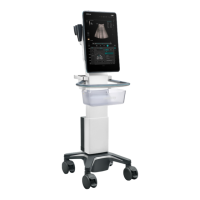6 Image Acquisition
Operator’s Manual 6 - 33
– Select [Table Display] to check parameters:
You can set range for the fit curve. After the range is set, the system displays fit curve within
the range only. Tap to the time-intensity curve to move the frame marker position.
a. Set starting point of the fit curve: Tap to select the starting time and select [Set Fit Start].
b. Set end of the fit curve: Tap to select the end time and select [Set Fit End].
7. Use [X Scale] on the touch screen to choose different value, so that the X scale display manner
will be changed.
This function can be used to track detailed tissue information.
8. Save the curved image, export the data and do parameter analysis.
a. Select [Export].
b. Select the drive and enter the file name in the displayed window.
c. Select [OK] to save the data and return to the QA Analysis screen.
All displayed ROI traces are saved in the exported file.
The parameters are included in the trace file if the user has fixed a ROI.
Only data from the user selected image range is included in the exported trace file.
9. Select [Exit] to exit Contrast QA.
6.15 Auto GA
Auto GA must be used with convex probe.
After acquired image(s) of gastric antrum, by freezing image and tapping the Auto GA button, the
feature shows boundary of gastric antrum and calculates the area of gastric antrum.
Perform the following procedure:
1. Scan and obtain the gastric antrum image and freeze the image.
Item Description
GOF (Goodness of Fit) Calculate the fit degree of the curve; range: 0-1, where 1 means
the fit curve fits the raw curve perfectly.
BI (Base Intensity) Basic intensity of no contrast agent perfusion status.
AT (Arrival Time) Time point where contrast intensity appears, generally, the actual
time value is 110% higher than the base intensity.
TTP (Time To Peak) Time when the contrast intensity reaches peak value.
PI (Peak Intensity) Contrast peak intensity.
AS (Ascending Slope) Ascending slope of contrast, the slope between the start point of
lesion perfusion to the peak.
DT/2 Time when the intensity is half the value of the peak intensity.
DS (Descending Slope) Descending slope of the curve.
AUC (Area Under Curve) To calculate the area under the time-intensity curves during
contrast.

